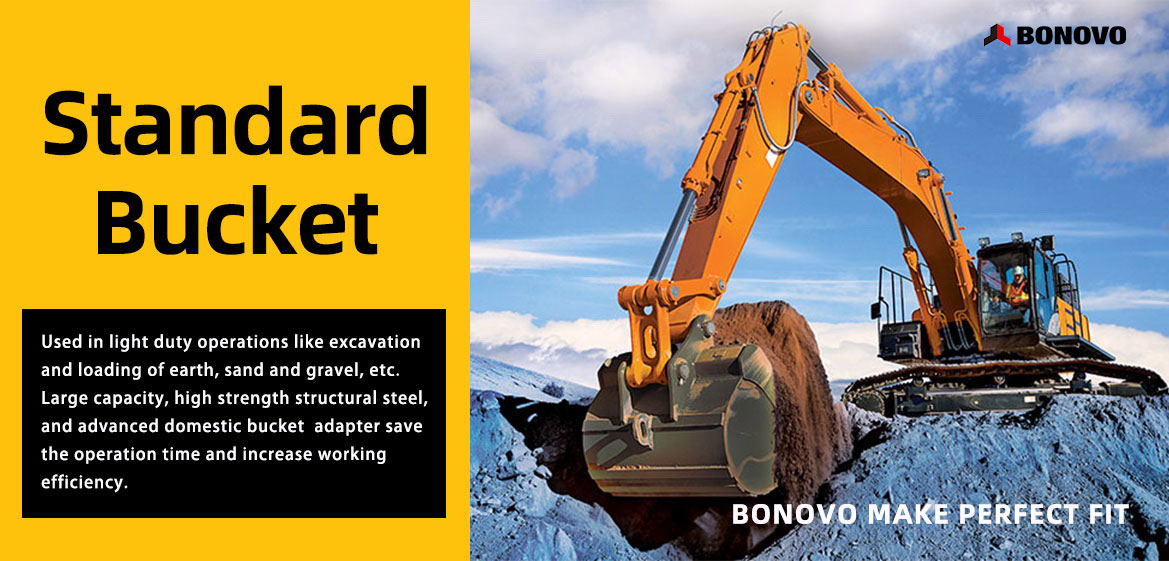Trackhoe Bucket: Buying and Maintenance Guide - Bonovo
The trackhoe bucket is a common working attachment on excavators, primarily used for excavating and loading earth, loose materials, and more. The shape and design of the bucket can vary based on the excavator model and job requirements, but they typically feature a large capacity and strong wear resistance.
The structure of the excavator trackhoe bucket typically comprises a bucket body, teeth, side plates, and ear plates. The bucket body is the main part, usually made of wear-resistant steel plates welded together to withstand significant impact and abrasion. The teeth are installed at the front end of the bucket body, used for cutting and excavating soil or loose materials. The side plates connect to the sides of the bucket body, preventing soil or materials from spilling out the sides. The ear plates connect to the rear end of the bucket body, allowing the bucket to be mounted on the excavator's boom and arm.
During operation, the excavator operator can control the trackhoe bucket through the boom and arm, performing actions such as excavation, loading, and unloading. Due to its large capacity, the bucket can excavate and load a significant amount of earth or loose materials at once, improving work efficiency.
It's crucial to prioritize safe operation and maintenance when using the trackhoe digging bucket. Especially when excavating hard or large materials, extra caution should be exercised to prevent excessive impact damage to the teeth or bucket body. Regularly checking and replacing severely worn parts are essential for ensuring the bucket's lifespan and safety.
Comprehensive Understanding and Maintenance Guide for the Excavator Bucket
The Trackhoe bucket, a crucial working attachment on excavators, is widely used for excavating and loading earth, loose materials, and more. To help you better understand and maintain your bucket, this article provides a comprehensive overview of its structure, types of teeth, and maintenance methods.
Structure and Types of Teeth
The excavator bucket is primarily composed of a bucket body, teeth, side plates, and ear plates. Among these, the teeth are a crucial cutting component. Based on their shape and application, they can be classified into several types, such as sharp teeth for softer soil, blunt teeth for harder or larger materials, chisel teeth for breaking hard materials, and flat teeth for general excavation.
Maintenance and Care
Proper maintenance is key to ensuring the long-term stable operation and lifespan of the bucket. Here are some recommended maintenance practices:
Regular cleaning: Use high-pressure water or air guns to clear debris, dirt, and stones from the bucket interior to prevent wear.
Inspecting wear: Periodically inspect the bucket body, teeth, side plates, and other components for wear. Replace severely worn parts promptly. Additionally, check the clearance between the teeth and bucket body; excessive clearance should be adjusted.
Lubrication: Regularly lubricate the bucket's moving parts to reduce friction and wear, improving efficiency.
Tightening loose parts: Periodically inspect fasteners and tighten them promptly to prevent component damage.
Collision prevention: When operating, avoid collisions with other objects or equipment, especially when excavating hard materials. Control the excavation depth and speed accordingly.
Maintenance records: Keep detailed maintenance records, including the date, content, and replaced parts, to aid in timely problem detection and resolution.
Purchase Advice for the Bucket
When purchasing a trackhoe bucket, consider the following advice:
Define your needs: Identify your specific excavation requirements. Different buckets are suitable for different working environments and materials. For instance, sharp teeth are ideal for softer soil, while blunt teeth are better for harder or larger materials.
Compatibility: Ensure the selected bucket is compatible with your excavator model. Different excavators may require differently sized buckets.
Quality and durability: Choose a reputable brand with a good reputation. High-quality buckets are made of wear-resistant and high-strength materials, withstanding harsh working conditions and extended use.
Maintenance considerations: Understand the bucket's maintenance requirements and consider whether the manufacturer offers technical support and after-sales service. This ensures the bucket maintains its optimal performance.
Cost-effectiveness: When comparing different brands and models, consider not just the purchase cost but also the lifespan, maintenance costs, and work efficiency. Choosing a cost-effective option saves you in the long run.
As a leading brand in excavator attachments, BONOVO offers high-quality, efficient buckets. We provide personalized customization services, ensuring compatibility with various excavator brands and models. Our buckets are made of high-strength wear-resistant materials, offering excellent excavation performance and durability. Additionally, we offer comprehensive technical support and after-sales service, ensuring optimal bucket performance throughout its usage. Choose BONOVO buckets for smoother, more efficient earth excavation work!





